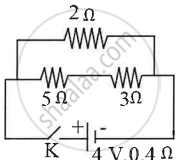Advertisements
Advertisements
प्रश्न
Name three factors on which resistance of a given wire depends and state how is it affected by the factors stated by you.
उत्तर
The following factors can affect a wire's resistance:
- Length of wire: The resistance increases as the wire length increases. R ∝ (l) (directly proportional).
- Area of cross-section (a): The area of the cross-section has an inverse relationship with resistance. For example, the resistance of a thick wire is lower than that of a thin one.
- Temperature (T): As the temperature rises, the resistance of the wire also rises.
APPEARS IN
संबंधित प्रश्न
Two copper wires are of the same length, but one is thicker than the other. Which wire will have more resistance?
How does the resistance of a wire depend on its radius? Explain your answer.
Draw a I–V graph for a linear resistor. What does its slope represent?
What happens to the resistance, as the conductor is made thicker?
An electric bulb is rated ‘240 V, 100 W’.
- What information can you get from the above statement?
- What will happen if this bulb is connected across 220 V?
- Calculate the resistance of the bulb.
- Also find the energy consumed by the bulb in 10 minutes.
The resistance of a conductor is R. If Its length is doubled, then its new resistance will be ______.
Resistors are connected in series if the resistance of the electric circuit is to be ______.
Three resistors are connected in parallel with a battery. If the current in each resistor is 2A, then the current through the battery will be ______.
The ______ is the measure of opposition offered by the component to the flow of electric current through it.
Observe the given circuit diagram and answer the questions that follow:

- Calculate the resistance of the circuit when the key K completes the circuit.
- Calculate the current through 3Ω resistance when the circuit is complete.
